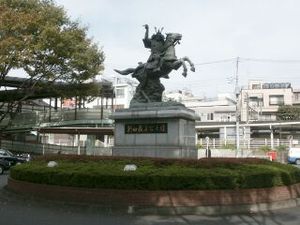- Nitta Yoshisada
-
In this Japanese name, the family name is "Nitta".
 Nitta Yoshisada in a painting by Kikuchi Yōsai.
Nitta Yoshisada in a painting by Kikuchi Yōsai.
Nitta Yoshisada (新田 義貞, 1301 – August 17, 1338) was the head of the Nitta family in the early fourteenth century, and supported the Southern Court of Emperor Go-Daigo in the Nanboku-chō period, capturing Kamakura from the Hōjō clan in 1333.
Long an enemy of Ashikaga Takauji, Nitta Yoshisada is often blamed for the split between the Northern and Southern Courts, as he fought against the Ashikaga and for the Emperor Go-Daigo. This rivalry came largely from the fact that the Ashikaga were ranked above the Nitta, despite their being descended from a younger ancestor; since the ancestors of the Nitta did not fight alongside their Minamoto cousins in the Genpei War, they were never accorded power or prestige at Kamakura.
In 1331, after being ordered by the bakufu (shogunate) to join an army at the Chihaya fortress, Nitta received summonses from Prince Morinaga and Emperor Go-Daigo to strike at the Hōjō, so he left his post. Returning to his home province of Kozuke, Nitta rallied the aid of other descendants & vassals including his brother Nitta Yoshisuke of the Minamoto clan, and began to march towards Kamakura through Musashi. On the approaches to the city, Nitta enjoyed some early victories, routing the Hōjō defenders and pursuing them towards the city.
Contents
The fall of Kamakura in 1333
 Nitta Yoshisada monument in Fuchū.
Nitta Yoshisada monument in Fuchū. Main article: Siege of Kamakura (1333)
Main article: Siege of Kamakura (1333)Kamakura on land is completely surrounded by steep hills, making an army attack very difficult. Nitta first tried to enter through the Gokurakuji Pass and the Kewaizaka Pass, but concentrated Hōjō forces stopped him. Judging it impossible to enter by land, Nitta decided to try by sea bypassing the Inamuragasaki Cape on Sagami Bay, west of Kamakura. Once there, Nitta took advantage of a low tide and moved his men in through the beaches to the south but, according to the Taiheiki, he threw his sword into the surf and prayed to Ryūjin[1], who parted the waters for him[2].
The stele at Sode no Ura (袖の浦), the tiny bay west of Inamuragaki, says[3]:
666 years ago on May 21, 1333[4] Nitta Yoshisada, judging an invasion on land to be difficult, decided to try to bypass this cape. This is the place where, according to tradition, he threw his golden sword into the waves, praying the sea-god[1] to withdraw them and let him pass. (Erected in 1917)
The city was taken, and the Hōjō clan's influence destroyed.
Following the fall of Kamakura (and of the Hōjō regency), Nitta was appointed Governor of Echigo and Vice-Governor of Harima and Kozuke Provinces, as Emperor Go-Daigo redistributed the Hōjō lands. Moreover, he courted Emperor Go-Daigo's secretary Kōtō-Naishi (匂当内侍), and married through the Emperor's mediation.
Death of Nitta Yoshisada
During the following few years, Nitta's rivalry with Ashikaga Takauji (and his brother Ashikaga Tadayoshi) came to a head, with the two planning rebellion, and issuing a call that "Nitta Yoshisada must be destroyed." They fought a number of battles, many of them in and around Kyoto, in the same locations as famous battles of the Genpei War; in the end, Nitta was defeated, but continued to be a thorn in Takauji's side until his death on July 2, 1338.
Nitta's death was as remarkable as his life. Turnbull (2003) writes that Nitta was fighting in the Siege of Kuromaru against Hosokawa Akiuji, an ally of Takauji, when his horse was felled by arrow fire. Nitta, pinned under the dead horse and unable to move was an easy target for archers. As a final act, Nitta drew his short sword and cut off his own head. Record has it that a number of his fellow samurai committed junshi seppuku nearby, in a show of allegiance.
Notes
- ^ a b In describing this event, Japanese sources say Nitta Yoshisada prayed to a sea-god or Ryūjin, English sources almost always refer to Sun Goddess Amaterasu. The Taiheiki itself (稲村崎成干潟事) says:
He therefore speaks to Ryūjin who, he has heard, is manifestation of Amaterasu.Dismounting from his horse, Yoshisada removed his helmet and prostrating himself across the distant seas prayed to Ryūjin. "It is said that the lord of Japan from the beginning, Amaterasu Ōmikami, enshrined at Ise Jingū, hid herself within a Vairocana and appeared as Ryūjin of the vast blue seas. My lord (Emperor Go-Daigo) is her descendant, and drifts upon waves of the western sea due to rebels. I Yoshisada, in an attempt to serve as a worthy subject, will pick up my axes and face the enemy line. That desire is to aid the nation and bring welfare to the masses. Ryūjin of the Eight Protectorate Gods of the (seven) Inner Seas and the Outer Sea, witness this subject’s loyalty and withdraw the waters afar, open a path to the lines of the three armies.
- ^ Mutsu (1995:247)
- ^ Original Japanese text available here
- ^ Old Japanese lunar calendar date. Gregorian date obtained directly from the original Nengō using Nengocalc: July 3, 1333 (Genkō 3, 21st day of the 5th month)
References
- Sansom, George (1958). 'A History of Japan to 1334'. Stanford, California: Stanford University Press.
- Turnbull, Stephen (1998). 'The Samurai Sourcebook'. London: Cassell & Co.
- Turnbull, Stephen (2003). 'Samurai: The World of the Warrior'. Osprey Publishing.
- Mutsu, Iso (1995/06). Kamakura. Fact and Legend. Tokyo: Tuttle Publishing. ISBN 0804819688.
Categories:- Samurai
- Japanese military personnel who committed suicide
- 1301 births
- 1338 deaths
- ^ a b In describing this event, Japanese sources say Nitta Yoshisada prayed to a sea-god or Ryūjin, English sources almost always refer to Sun Goddess Amaterasu. The Taiheiki itself (稲村崎成干潟事) says:
Wikimedia Foundation. 2010.
